Related Research Articles
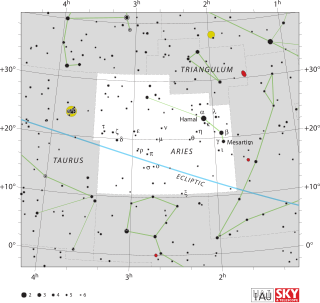
Aries is one of the constellations of the zodiac. It is located in the Northern celestial hemisphere between Pisces to the west and Taurus to the east. The name Aries is Latin for ram. Its old astronomical symbol is (♈︎). It is one of the 48 constellations described by the 2nd century astronomer Ptolemy, and remains one of the 88 modern constellations. It is a mid-sized constellation ranking 39th in overall size, with an area of 441 square degrees.
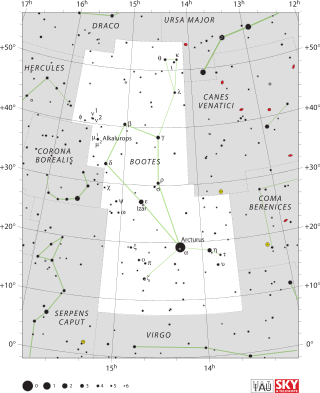
Boötes is a constellation in the northern sky, located between 0° and +60° declination, and 13 and 16 hours of right ascension on the celestial sphere. The name comes from Latin: Boōtēs, which comes from Greek: Βοώτης, translit. Boṓtēs 'herdsman' or 'plowman'.

In economics, the Gini coefficient, also known as the Gini index or Gini ratio, is a measure of statistical dispersion intended to represent the income inequality, the wealth inequality, or the consumption inequality within a nation or a social group. It was developed by statistician and sociologist Corrado Gini.

The Leonids are a prolific meteor shower associated with the comet Tempel–Tuttle, which are also known for their spectacular meteor storms that occur about every 33 years. The Leonids get their name from the location of their radiant in the constellation Leo: the meteors appear to radiate from that point in the sky. Their proper Greek name should be Leontids, but the word was initially constructed as a Greek/Latin hybrid and it has been used since. The meteor shower peak should be on 17 November, but any outburst is likely to be from the 1733 meteoroid stream.
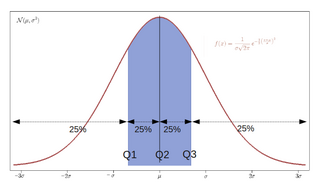
In statistics and probability, quantiles are cut points dividing the range of a probability distribution into continuous intervals with equal probabilities, or dividing the observations in a sample in the same way. There is one fewer quantile than the number of groups created. Common quantiles have special names, such as quartiles, deciles, and percentiles. The groups created are termed halves, thirds, quarters, etc., though sometimes the terms for the quantile are used for the groups created, rather than for the cut points.

A meteoroid is a small rocky or metallic body in outer space. Meteoroids are distinguished as objects significantly smaller than asteroids, ranging in size from grains to objects up to a meter wide. Objects smaller than meteoroids are classified as micrometeoroids or space dust. Most are fragments from comets or asteroids, whereas others are collision impact debris ejected from bodies such as the Moon or Mars.
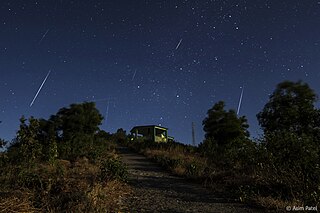
The Geminids are a prolific meteor shower caused by the object 3200 Phaethon, which is thought to be a Palladian asteroid with a "rock comet" orbit. This would make the Geminids, together with the Quadrantids, the only major meteor showers not originating from a comet. The meteors from this shower are slow moving, can be seen in December and usually peak around December 4–16, with the date of highest intensity being the morning of December 14. The shower is thought to be intensifying every year, and recent showers have seen 120–160 meteors per hour under optimal conditions, generally around 02:00 to 03:00 local time. Geminids were first observed in 1862, much more recently than other showers such as the Perseids and Leonids.

A meteor shower is a celestial event in which a number of meteors are observed to radiate, or originate, from one point in the night sky. These meteors are caused by streams of cosmic debris called meteoroids entering Earth's atmosphere at extremely high speeds on parallel trajectories. Most meteors are smaller than a grain of sand, so almost all of them disintegrate and never hit the Earth's surface. Very intense or unusual meteor showers are known as meteor outbursts and meteor storms, which produce at least 1,000 meteors an hour, most notably from the Leonids. The Meteor Data Centre lists over 900 suspected meteor showers of which about 100 are well established. Several organizations point to viewing opportunities on the Internet. NASA maintains a daily map of active meteor showers.

In astronomy, the zenithal hourly rate (ZHR) of a meteor shower is the number of meteors a single observer would see in an hour of peak activity if it was at the zenith, assuming the seeing conditions are excellent. The rate that can effectively be seen is nearly always lower and decreases the closer the radiant is to the horizon.

The Perseids are a prolific meteor shower associated with the comet Swift–Tuttle. The meteors are called the Perseids because the point from which they appear to hail lies in the constellation Perseus.
The Quadrantids (QUA) are a meteor shower that peaks in early January and whose radiant lies in the constellation Boötes. The zenithal hourly rate (ZHR) of this shower can be as high as that of two other reliably rich meteor showers, the Perseids in August and the Geminids in December, yet Quadrantid meteors are not seen as often as those of the two other showers because the time frame of the peak is exceedingly narrow, sometimes lasting only hours. Moreover, the meteors are quite faint, with mean apparent magnitudes between 3.0 and 6.0.

In statistics, as opposed to its general use in mathematics, a parameter is any measured quantity of a statistical population that summarises or describes an aspect of the population, such as a mean or a standard deviation. If a population exactly follows a known and defined distribution, for example the normal distribution, then a small set of parameters can be measured which completely describes the population, and can be considered to define a probability distribution for the purposes of extracting samples from this population.

8P/Tuttle is a periodic comet with a 13.6-year orbit. It fits the classical definition of a Jupiter-family comet with an orbital period of less than 20 years, but does not fit the modern definition of. Its last perihelion passage was 27 August 2021 when it had a solar elongation of 26 degrees at approximately apparent magnitude 9. Two weeks later, on September 12, 2021, it was about 1.8 AU (270 million km) from Earth which is about as far from Earth as the comet can get when the comet is near perihelion.
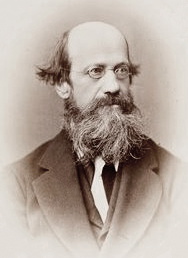
Joseph Lovering was an American scientist and educator.
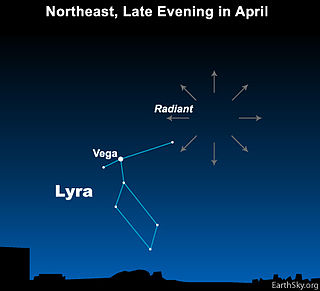
The April Lyrids are a meteor shower lasting from April 16 to April 25 each year. The radiant of the meteor shower is located in the constellation Lyra, near its brightest star, Vega. The peak of the shower is typically around April 22 each year.

The Andromedids meteor shower is associated with Biela's Comet, the showers occurring as Earth passes through old streams left by the comet's tail. The comet was observed to have broken up by 1846; further drift of the pieces by 1852 suggested the moment of breakup was in either 1842 or early 1843, when the comet was near Jupiter. The breakup led to particularly spectacular showers in subsequent cycles.
The Virginids are a meteor shower. There are many major and minor meteor shower streams that occur during the Virginid Complex, including the Alpha Virginids, Gamma Virginids, Eta Virginids, Theta Virginids, Iota Virginids, Lambda Virginids, Mu Virginids, Pi Virginids, and Psi Virginids, and March Virginids, emanating mostly from the constellation Virgo between February and May. Collectively, the shower normally lasts from late January to mid-April and into early May, peaking in March and April, with one to two meteors per hour on average. The main radiant shifts southeastwards from central Leo in late January to central Virgo near Spica in mid-May.

Alpha Capricornids is a meteor shower that takes place as early as 7 July and continues until around 15 August. The meteor shower was discovered by Hungarian astronomer Miklos von Konkoly-Thege in 1871. This shower has infrequent but relatively bright meteors, with some fireballs. Parent body is comet 169P/NEAT.

Comae Berenicids [sic] is a minor meteor shower with a radiant in the constellation Coma Berenices. The shower appears from December 12 to December 23 with the estimated maximum around December 16. The radiant at that time is located at α=175°, δ=+18°. The shower's population index is 3.0 with the speed of 65 kilometres per second (40 mi/s).
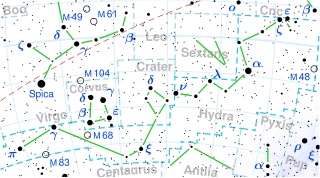
Sigma Hydrids are faint, minor meteor shower with peak on 9 December. ZHR is 3-5 and population index is 3. They are active from December 3 to 20.
References
- ↑ Molau, Sirko (2015). "Introduction". Population index reloaded (Thesis). Harvard University. Retrieved 11 July 2023.
